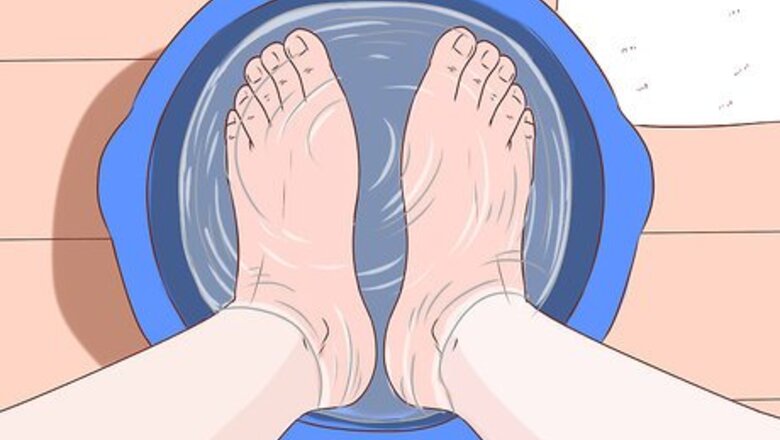
views
Removing Calluses at Home

Soak your feet on a regular basis. If you have calluses, try soaking your feet on a regular basis to soften the dry and dead skin. Softening the skin with a warm water and mild soap foot bath will make removing that skin much easier. Use warm water instead of hot water. Hot water can dry out your skin and irritate your feet. If you have diabetes, then you should wash your feet every day. Use lukewarm water with a mild soap and dry your feet well. Then, moisturize your feet with some lotion, petroleum jelly, or baby oil.
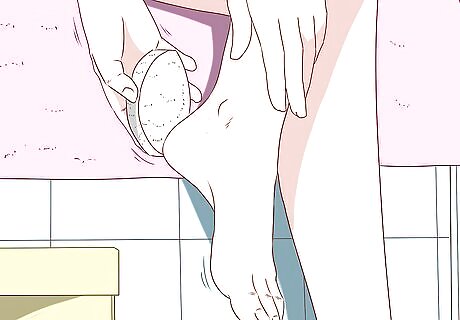
Remove your calluses with a pumice stone or foot file. After you’ve soaked your feet, or had a shower or bath, use a pumice stone, foot file or emery board to remove excess dead skin from your calluses. Pumice stones and foot files work better if you wet them in warm water before using them. If you do not have a pumice stone, foot file or emery board, you can also use a wash cloth to scrub away the dead skin. After you’ve scrubbed your feet, apply moisturizer to your feet to lock in the moisture and keep the skin on your feet soft and pliable. If you have diabetes, make sure that you ask your doctor before using a pumice stone to remove calluses.
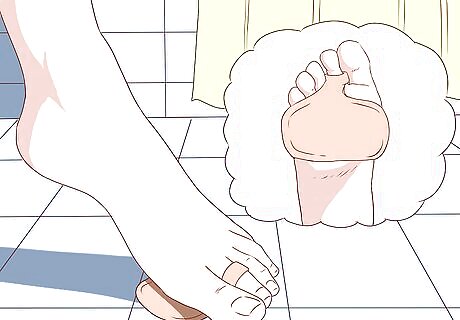
Protect certain parts of your feet. Calluses (and corns) develop on areas of your feet that rub against your shoes and socks when you’re walking. You might find you have some shoes that are worse than others in this regard. Your first choice should be to wear shoes that fit properly so they do not cause calluses or corns, but as an alternative you can use over-the-counter unmedicated pads to protect your feet. These pads come in various sizes and shapes for different parts of your feet, but they also come in larger-sized squares that can be cut to size for whatever area you want. Some of these pads come in a medicated version, however you should avoid the medicated versions unless directed to use them by a doctor.

Make an appointment to see your doctor. If you have calluses or corns that have become extremely painful or swollen, you should consider making an appointment to see your doctor to discuss the best course of action. A doctor has the proper facilities and equipment to potentially cut off the excess skin from a callus or corn. This should never be done at home. A doctor may also suggest or prescribe an antibiotic ointment (like Polysporin) to use on a corn or callus if it has become infected, or there is the possibility it will become infected.
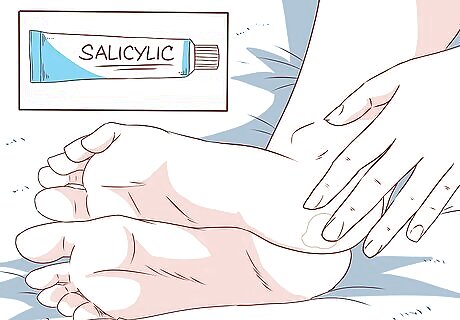
Use callus-removing medication. There are several medicinal options to help with calluses that your doctor may suggest. Small patches that contain a 40% salicylic acid solution can be used directly on a callus or corn to help soften the skin for easier removal. These patches can be purchased over-the-counter at a drug store under several brand names. If you doctor does not provide instructions on when and how often to use these patches, follow the instructions on the package. Prescription-strength salicylic acid gel is also available for areas larger than a patch can cover. You should only use salicylic acid with a doctor’s guidance. Because it is an acid, it does have the ability to burn and irritate your skin, which in turn can lead to an infection. Your doctor will instruct you on which products to use, how often to use them, and how much to use each time.
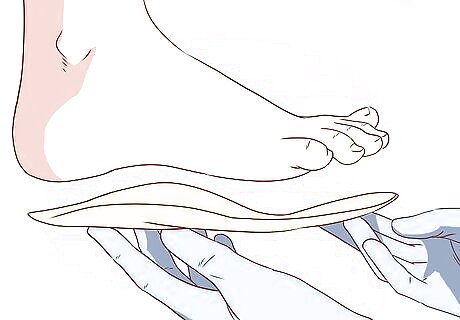
Obtain custom-made shoe inserts. One reason you may have calluses is due to a foot deformity. The deformity could be quite minor, but it could be enough to cause excess rubbing of certain parts of your feet against the insides of your shoes. Obtaining custom-made shoe inserts or orthotics could help fix the deformity and reduce your chances of getting a callus.
Taking Good Care of Your Feet
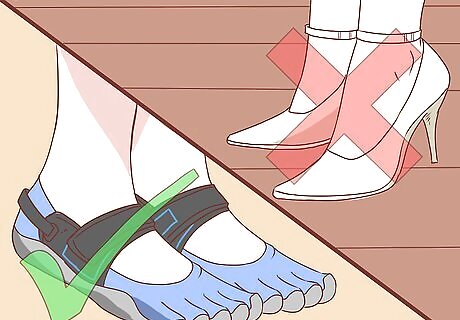
Select the proper shoes. Buying and wearing the proper shoes will go a long way to help prevent calluses from forming on your feet. There are several things you can be on the lookout for when shopping for new shoes, including: Make sure the salesperson measures both of your feet. Chances are, like most people, you have one foot that is larger than the other. You’ll want to select a shoe size that fits the larger of your two feet. Leave shopping for shoes till as late as possible. Throughout the day your feet swell and you want to size your shoes based on your swollen feet. This ensures that your shoes are large enough to accommodate your swollen feet and won’t become uncomfortable as the day goes on. Buy shoes based on how they actually feel on your feet, even if the size on the shoe doesn’t make sense. While it may seem obvious, buy shoes that are shaped like feet. Many ‘stylish’ shoes come in odd shapes which can end up hurting your feet and causing calluses. When trying on new shoes, make sure your whole foot feels comfortable inside the shoe — from the tips of your toes, to the balls of your feet, to your heel. Leave approximately ⅜” to ½" of space at the tip of the shoe between the end of your big toe and the start of the shoes.

Keep your feet dry. Socks can be just as important as shoes in keeping your feet callus-free and healthy. Cotton socks, or socks made of a natural fiber, are the best type for keeping your feet dry inside of your shoes. This is especially important when you’re doing any type of physical activity where you’ll sweat more than usual. Make sure to allow your shoes to dry out before wearing them again — don’t put on wet footwear. Avoid wearing the same socks two days in a row if you can, especially if they get wet or sweaty. If you socks do get wet, change them as soon as possible. Remember to wash your feet every day as part of your regular cleaning routine, including between your toes. Plus, after you’ve washed your feet, make sure they’re completely dry before putting socks on. Also consider wearing flip-flops or sandals when walking around a public swimming pool and even inside a public shower.
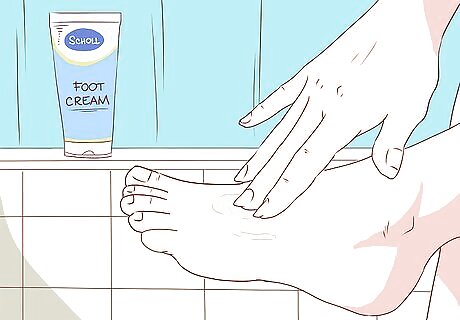
Moisturize your feet every day. Calluses form because of spots on your feet that rub against your socks and shoes. But you can help prevent and heal calluses by moisturizing your feet every day and keeping the skin nice and soft. Keeping your feet moisturized and soft is even more important in the winter time when the air is colder, and therefore drier. Don’t apply moisturizer and then attempt to walk around in your bare feet, this can be dangerous! Get into the habit of applying moisturizer to your feet right before you go to bed. Take the opportunity to give your feet a massage when applying the moisturizer. This feels great, but also increases blood circulation in your feet. If possible, buy and use only moisturizer designed for feet on your feet.
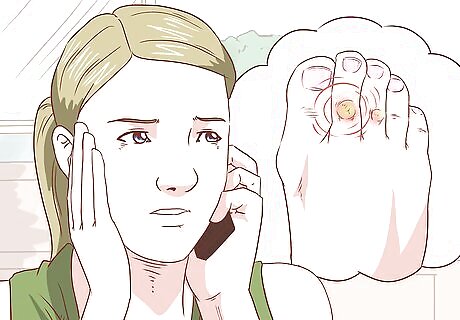
Work to avoid and remove corns. Corns are calluses, but they’re calluses that form on your toes instead of other parts of your feet. Corns are usually caused by the tips of your shoes rubbing against your toes. And this in turn can be caused by shoes that are too small in the toe area, or by high heels that are forcing your feet downwards due to gravity. Removing and preventing corns can be accomplished using the same methods as you would for calluses, but make an appointment to see your doctor if they get really severe and painful.
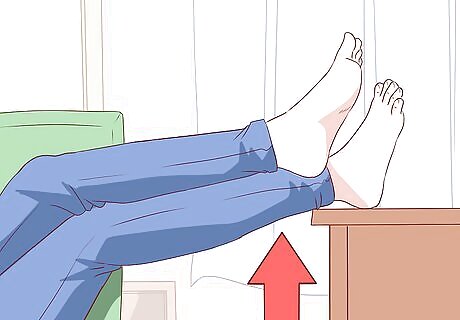
Put your feet up. Resting your feet on a regular basis is also very important. Your feet need a break from the stress just like any other part of your body. Plus, if you tend to sit with your legs crossed, change the leg that’s on top every now and again to improve circulation.
Trying Other Ways to Pamper Your Feet
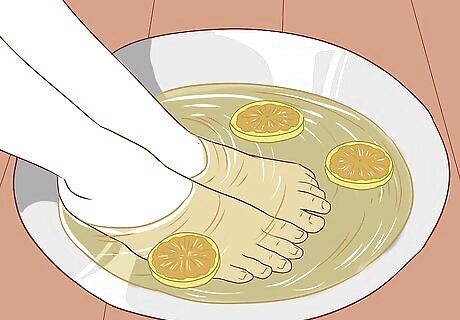
Soak your feet in lemon juice. The acid in lemon juice can be very helpful with softening and removing calluses. Soak your feet in lemon juice for about 10 minutes before scrubbing your feet with a pumice stone or foot file. While foot razors or shavers can be purchased at drug stores and pharmacies, they are not a good idea to use. They can easily cut your feet, and these cuts can easily become infected.
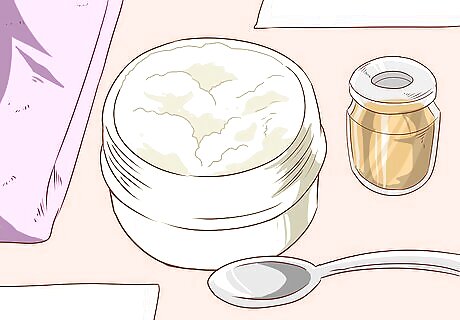
Make your own cracked-heel cream. Your heels tend to be one of the places that build up a lot of calluses. You can help keep your heels, and the rest of your feet, soft and moisturized by making your own cracked-heel cream at home. All you need to do is put a spoonful of olive oil in a small bottle and add a few drops of lemon or lavender essential oil. Shake the bottle until the liquid turns thick and milky and then apply it to your feet, specifically your heels. You can make this cream and store it for future use as long as you remember to shake the bottle before you use it.

Oil your feet before bed. The best time to moisturize your feet is right before bed. And you can moisturize your feet with more than just store-bought moisturizer — you can also use vegetable oil. Simply apply a layer of vegetable oil to your feet before bed and then put on a pair of thick socks. Leave the socks on all night while you sleep and then wipe off any excess oil in the morning. Vegetable oil (and other oils) can stain fabrics, including your socks and sheets. The best socks to use in this situation are wool socks, as the wool absorbs the oil and doesn’t stain. If you can’t use wool socks (or if they’re too hot) use a pair of old socks instead.

Create your own overnight foot mask. Your face, hands and hair can benefit from masks — so can your feet! It’s easy to make your own at home using 1 tablespoon of Vaseline (or another similar product) and the juice from 1 lemon. Mix the Vaseline and lemon juice together in a bowl and apply the mixture to your clean feet before bed. Wear a pair of socks on your feet all night and wipe off the excess Vaseline with a towel in the morning. Dedicate a pair of old socks to this process so you don’t have to worry about the Vaseline staining them, or your sheets.
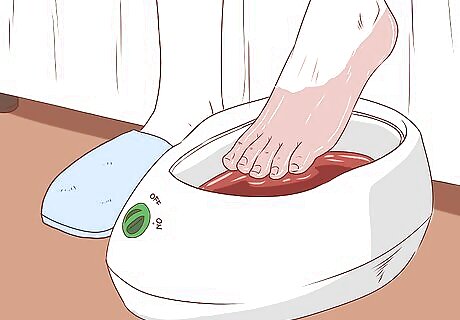
Try paraffin wax to moisturize your feet. Aestheticians often use paraffin wax as part of a spa pedicure, but you can also use paraffin wax at home. Simply melt the wax in a large bowl in the microwave and add an equal amount of mustard oil after the wax is melted. (The mustard oil is what moisturizes your feet.) Dip each of your feet in the bowl of wax (once it’s cool enough) twice, waiting enough time between dips to make sure the wax has dried on your feet. Then wrap your feet in plastic wrap or a plastic bag for 15 minutes. Remove the plastic and the wax at the same time.


















Comments
0 comment